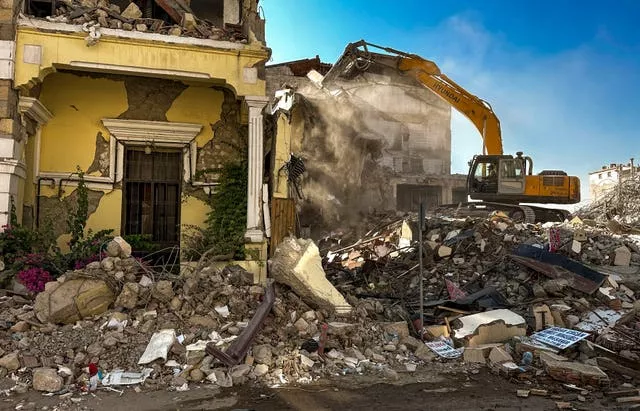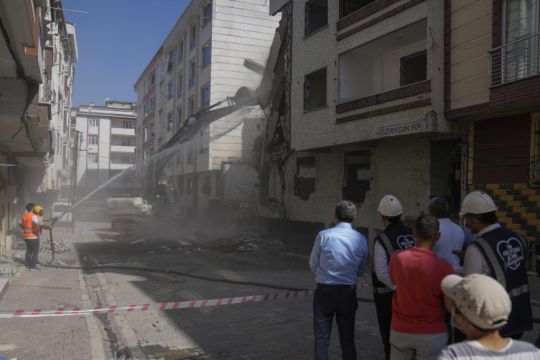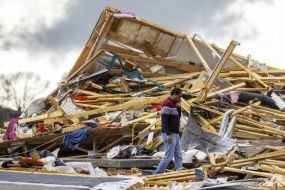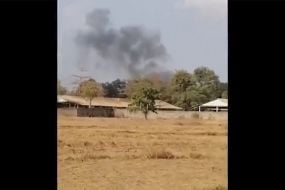Dust and rubble fill the street as an excavator tears off chunks of concrete from an old apartment building in Istanbul, while former residents watch from afar.
Among the bystanders is Ibrahim Ozaydin, 30, a former resident. He watches the demolition not with worry, but with relief, as his building was marked by officials as unsafe months ago.
Mr Ozaydin and his family were shocked to learn that the municipality deemed his building uninhabitable. They have now built their own house, “let us take our own precautions,” he said.
The sight of construction vehicles demolishing buildings became ingrained in Turkish minds six months ago, after a devastating 7.8-magnitude earthquake hit Kahramanmaras and 10 other provinces in southern Turkey on the morning of February 6.
More than 50,000 people died, and hundreds of thousands were left homeless, sheltering in tents and other temporary accommodation.
The International Labour Organisation estimates that some 658,000 people were left jobless. As for the material cost, some 300,000 buildings were damaged. Survivors needed to be rescued, rubble to be cleared and buildings on the verge of collapse torn down.

Yet this latest demolition is taking place in Istanbul, Turkey’s largest metropolis, far away from the earthquake zone. This time the building was not torn down as part of search-and-rescue efforts, but to prevent such harrowing scenes in the future.
The building was occupied only by Mr Ozaydin and his extended family, who also owned a shop on the ground floor. The family managed to relocate their shop and build a new, sturdier house at a different location, but theirs is an exceptional story in a city where hundreds of thousands of buildings are at risk and property prices are soaring.
Istanbul lies on a major fault line, one which experts warn could break at any moment. In a bid to prevent damage from any future quake, both the national government and local administrations are racing against time to alleviate the pain of the February quake while also preparing their cities for potential disasters in the future.
However, even preparedness can fall victim to political rivalry: the authorities in opposition-held Istanbul municipality and the national government in Ankara cannot agree on the exact number of buildings at risk of crumbling in the event of an earthquake. But both put the figure at hundreds of thousands.
After the February tragedy, the Istanbul municipality headed by Mayor Ekrem Imamoglu, a prominent figure in the opposition to President Recep Tayyip Erdogan, earmarked for demolition 318 buildings housing more than 10,000 people.
Bugra Gokce, an official with the Istanbul municipality overseeing the demolition, said: “We are identifying buildings at risk of collapse and fortifying others, all to reduce the potential loss of life.”
During a heated election campaign right before his re-election to a third decade in power, Mr Erdogan pledged to construct 319,000 new homes within the year. He attended many groundbreaking ceremonies as he persuaded voters that only he could rebuild lives and businesses.

“It’s easy to say, ‘we are building this many square meters atop a hill’ or ‘5,000 residences are being built somewhere’,” adds Mr Gokce, in an apparent jab at the national government’s urban transformation programmes.
“We are also doing that. But if you’re not also reducing the risk to existing buildings in the city, it is nothing more than urban expansion.”
Both experts and Erdogan critics argue that the sheer scale of February’s destruction was due to the president’s weak enforcement of building codes amidst a construction boom that helped drive economic growth.
Ankara launched several programmes aimed at inspecting damaged buildings both in and outside the 11 provinces hit by the earthquake. Meanwhile victims have been offered both financial aid and a chance to resettle in public housing projects built by the Housing Development Administration of Turkey, or TOKI.
Although many promises were made by both the ruling party and the opposition in the lead-up to the elections in May, those still in the earthquake-affected provinces are demanding faster action.
Lawyer Mehmet Ali Gumus in Hatay province, one of the worst hit by the earthquake, said people are starting to lose hope. He said there are no signs of reconstruction in Hatay, and the emergency shelter situation in Antakya, Hatay’s most populated city, is deteriorating by the day.
People are living in metal shipping containers and tents in sweltering heat that can reach up to 42C without any access to air conditioning. Residents must also contend with flies, snakes and other wildlife while living outdoors, according to Mr Gumus.

Another health risk is the rubble from collapsed buildings, which is being dumped on farmland, shores, and even right outside encampments where survivors are staying. “Everyone around me says that we survived the earthquake, but they’ll be dealing with cancer in five-10 years because of the asbestos (from the rubble),” adds Mr Gumus.
In a social media post on July 15, the Hatay governor’s office stated that levels of asbestos in the rubble are safe and below the “regulatory limit”. Results showing low amount of asbestos taken from samples collected in debris dumping grounds were also posted.
While Hatay residents deal with the elements and other environmental hazards, their future remains uncertain.
“There were concrete statements before the elections, but afterwards we stopped hearing anything concrete,” continues Mr Gumus, claiming that the government has not committed to securing new houses for victims or even to fortifying their existing residences.
“Six months after the disaster we should be talking about newly built residences, not lines of people waiting for water,” he adds.
Another Hatay resident, Bestami Coskuner, is leaving for the western province of Izmir because of the power cuts and water shortages in his hometown.
“Tap water is not potable, but people use it to wash. Pipes burst daily, and power is cut two or three times a day,” Mr Coskuner said. Water is rationed, he said, and some who drank from the tap came down with serious illnesses.
“You can’t easily drink water. In a place where you can’t easily drink water, how are you going to make any decisions? Even bottled water tastes bad in Hatay,” he added.







